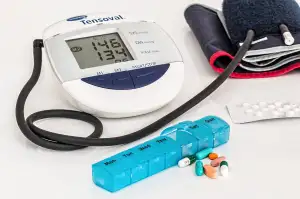Unlock the Benefits of Fascia Stretching with the Revolutionary Facia Stretcher: Enhance Your Health and Well-being

- Understanding the fascia and its importance in the body
- How the fascia stretcher works to stretch and release tension in the fascia
- Benefits of using a fascia stretcher for overall health and well-being
- Tips for using a fascia stretcher effectively and safely
- Exploring different types of fascia stretchers available in the market
- Expert recommendations on incorporating fascia stretching into your daily routine
- Real-life success stories of individuals who have experienced the benefits of using a fascia stretcher
- Frequently asked questions about fascia stretching and the fascia stretcher
Introduction to the Fascia Stretcher: Unlocking the Benefits of Fascia Stretching for Optimal Health
In our quest for better health and well-being, we often overlook an essential component of our body - the fascia. The fascia is a connective tissue that surrounds and supports every muscle, organ, and bone in our body. It plays a crucial role in maintaining flexibility, stability, and overall physical function.
To enhance the health of our fascia, a revolutionary tool has emerged - the fascia stretcher. This innovative device is designed to stretch and release tension in the fascia, promoting improved circulation, flexibility, and overall well-being.
By incorporating regular use of a fascia stretcher into your routine, you can unlock numerous benefits for your body. From relieving chronic pain to enhancing athletic performance, this simple yet effective tool has the potential to transform your health journey.
Join us as we delve deeper into the world of fascia stretching and explore how the fascia stretcher can become your key to unlocking optimal health and well-being.
Understanding the fascia and its importance in the body
How the fascia stretcher works to stretch and release tension in the fasciaThe fascia stretcher is designed to target and stretch the fascia, a connective tissue that surrounds muscles, organs, and joints in the body. It works by applying gentle pressure to specific areas, allowing the fascia to elongate and release tension. This helps improve flexibility, range of motion, and overall mobility. The stretching action also stimulates blood flow, promoting healing and reducing inflammation. By regularly using a fascia stretcher, you can effectively alleviate muscle tightness and discomfort caused by stress or physical activity.
Benefits of using a fascia stretcher for overall health and well-being
Using a fascia stretcher can provide numerous benefits for overall health and well-being. Firstly, it helps to improve flexibility and range of motion by stretching and releasing tension in the fascia. This can lead to increased mobility and reduced risk of injuries. Secondly, regular use of a fascia stretcher can help to alleviate chronic pain and discomfort caused by tight or restricted fascia. Additionally, it promotes better posture and alignment, which can have a positive impact on spinal health. Lastly, using a fascia stretcher aids in relaxation and stress reduction, as it stimulates the release of endorphins and promotes a sense of well-being.
Tips for using a fascia stretcher effectively and safely
1. Start slowly: Begin with gentle stretches and gradually increase the intensity over time. This allows your body to adapt and prevents any potential injuries.
2. Listen to your body: Pay attention to how your body feels during the stretching process. If you experience any pain or discomfort, adjust the intensity or stop altogether.
3. Warm-up before stretching: Engage in light aerobic exercises or a short walk to warm up your muscles before using the fascia stretcher. This helps prepare your body for stretching and reduces the risk of injury.
4. Maintain proper form: Ensure that you are using the fascia stretcher correctly by following the instructions provided. Incorrect form may lead to ineffective stretching or strain on other muscles.
5. Breathe deeply: While using the fascia stretcher, focus on deep breathing to relax your body and enhance the effectiveness of the stretch.
6. Be consistent: Incorporate regular fascia stretching sessions into your routine for optimal results. Consistency is key in reaping the long-term benefits of improved flexibility and reduced tension.
Remember, it's always advisable to consult with a healthcare professional or a certified trainer before starting any new exercise regimen, including using a fascia stretcher.
Exploring different types of fascia stretchers available in the market
When it comes to fascia stretchers, there are various options available in the market. One popular type is the foam roller, which is a cylindrical tool made of dense foam. Foam rollers come in different sizes and densities to cater to individual needs. Another type is the massage ball, which is a small ball typically made of rubber or silicone. Massage balls are designed to target specific areas of the body and provide deep tissue massage. Additionally, there are also specialized tools such as the fascia blaster, which uses multiple claws to penetrate and manipulate the fascia. It's important to choose a fascia stretcher that suits your preferences and needs for optimal results.
Expert recommendations on incorporating fascia stretching into your daily routine
1. Start slowly: Begin with gentle stretches and gradually increase intensity to avoid injury.
2. Consistency is key: Incorporate fascia stretching into your daily routine for optimal results. Aim for at least 10-15 minutes of stretching each day.
3. Listen to your body: Pay attention to any discomfort or pain during stretching. Modify or stop exercises if necessary.
4. Combine with other activities: Incorporate fascia stretching before or after workouts, yoga, or other physical activities to enhance flexibility and prevent muscle tightness.
5. Use proper technique: Follow instructions provided with the fascia stretcher and ensure correct form to maximize benefits and minimize risk of injury.
6. Seek guidance from professionals: Consult a certified trainer, physical therapist, or chiropractor who can provide personalized advice and guidance on incorporating fascia stretching into your routine.
Remember, everyone's body is unique, so it's important to find a routine that works best for you. With regular practice and proper technique, incorporating fascia stretching into your daily routine can help improve flexibility, reduce muscle tension, and promote overall health and well-being.
1. Start slowly: Begin with gentle stretches and gradually increase intensity to avoid injury.
2. Consistency is key: Incorporate fascia stretching into your daily routine for optimal results. Aim for at least 10-15 minutes of stretching each day.
3. Listen to your body: Pay attention to any discomfort or pain during stretching. Modify or stop exercises if necessary.
4. Combine with other activities: Incorporate fascia stretching before or after workouts, yoga, or other physical activities to enhance flexibility and prevent muscle tightness.
5. Use proper technique: Follow instructions provided with the fascia stretcher and ensure correct form to maximize benefits and minimize risk of injury.
6. Seek guidance from professionals: Consult a certified trainer, physical therapist, or chiropractor who can provide personalized advice and guidance on incorporating fascia stretching into your routine.
Remember, everyone's body is unique, so it's important to find a routine that works best for you. With regular practice and proper technique, incorporating fascia stretching into your daily routine can help improve flexibility, reduce muscle tension, and promote overall health and well-being.
Real-life success stories of individuals who have experienced the benefits of using a fascia stretcher
Real-life success stories of individuals who have incorporated the use of a fascia stretcher into their daily routine are a testament to its effectiveness. Sarah, a 35-year-old office worker, experienced chronic back pain for years. After using a fascia stretcher consistently for several weeks, she noticed a significant reduction in her pain and improved flexibility. John, a professional athlete, credits his enhanced performance and reduced risk of injury to regular fascia stretching with the help of a fascia stretcher. These real-life examples highlight the tangible benefits that can be achieved through the use of a fascia stretcher.
Frequently asked questions about fascia stretching and the fascia stretcher
Frequently Asked Questions about Fascia Stretching and the Fascia Stretcher:
1. What is fascia stretching?
Fascia stretching involves the deliberate elongation and release of the body's connective tissue called fascia. It aims to improve flexibility, relieve muscle tension, and enhance overall well-being.
2. Is fascia stretching safe?
Yes, when performed correctly, fascia stretching is safe for most individuals. However, it is advisable to consult with a healthcare professional before starting any new exercise routine, especially if you have any underlying health conditions.
3. How often should I use a fascia stretcher?
The frequency of using a fascia stretcher depends on individual needs and preferences. Starting with a few minutes daily and gradually increasing the duration can be beneficial. Listen to your body and adjust accordingly.
4. Can anyone use a fascia stretcher?
Most people can benefit from using a fascia stretcher. However, those with certain medical conditions or injuries should consult their healthcare provider before incorporating it into their routine.
5. Are there any side effects of using a fascia stretcher?
When used properly, there are generally no significant side effects associated with using a fascia stretcher. However, some individuals may experience temporary soreness or discomfort as their body adjusts to the stretching.
6. Can I use a fascia stretcher if I am pregnant?
Pregnant women should consult their healthcare provider before using a fascia stretcher to ensure it is safe for them during pregnancy.
7. How long does it take to see results from using a fascia stretcher?
Results vary depending on individual factors such as consistency, effort, and existing flexibility levels. Some individuals may experience immediate relief while others may notice improvements over time with regular use.
8. Can I combine other exercises with fascia stretching?
Yes! Combining other exercises like yoga or Pilates can complement your fascia stretching routine and provide additional benefits for overall health and flexibility.
Remember, it is always best to consult with a healthcare professional or certified trainer for personalized advice regarding fascia stretching and the use of a fascia stretcher.
In conclusion, the fascia stretcher is a revolutionary tool that plays a significant role in maintaining a healthy and flexible body. By stretching and releasing tension in the fascia, it promotes overall health and well-being. Regular use of a fascia stretcher can improve flexibility, reduce muscle soreness, enhance athletic performance, and prevent injuries. Incorporating fascia stretching into your daily routine can have long-lasting benefits for your physical and mental health. Unlock the potential of your body with the fascia stretcher and experience the transformative effects on your well-being.
Published: 19. 02. 2024
Category: Health



